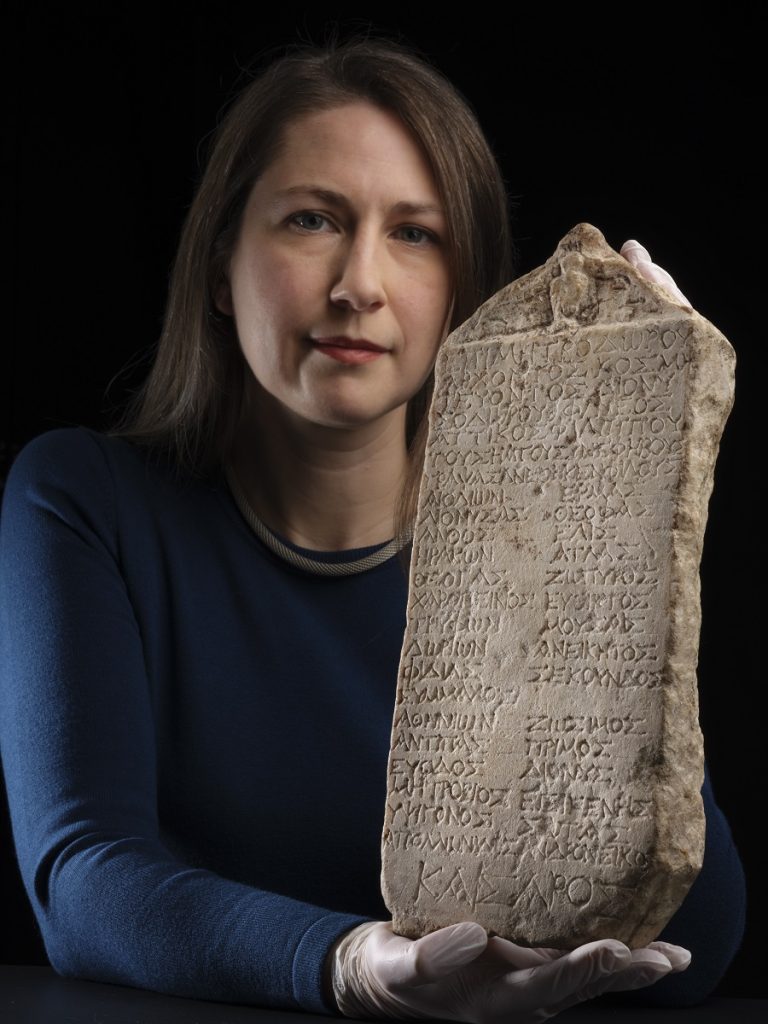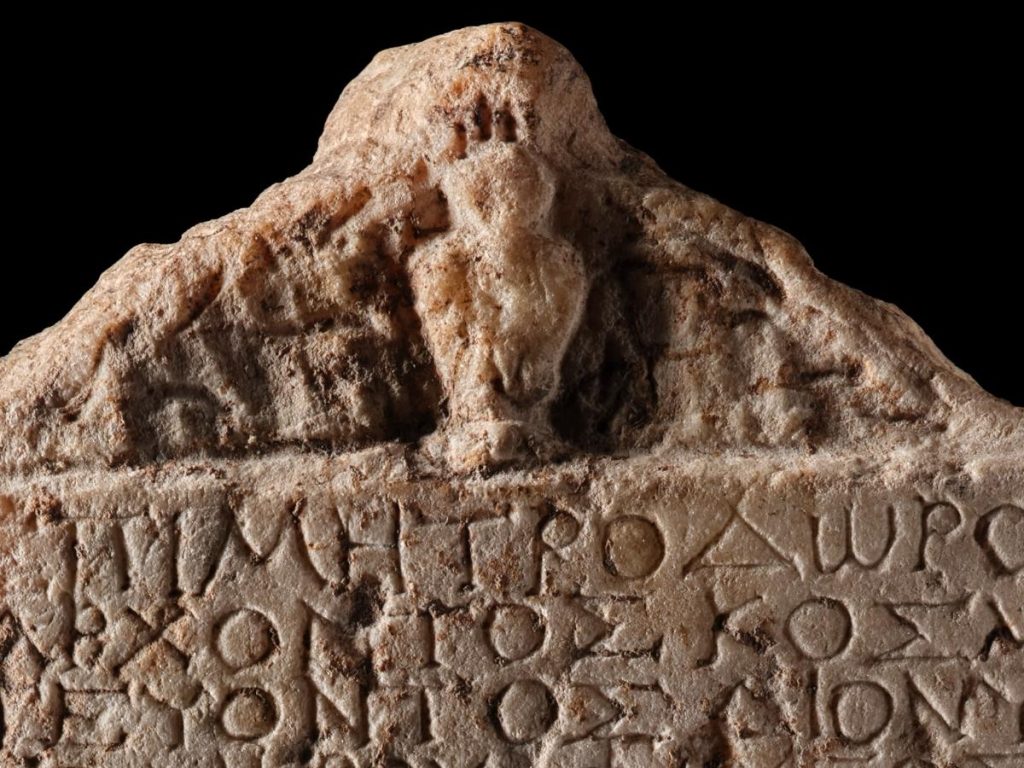A stone monument with an ancient Greek inscription in the collections of National Museums Scotland was recently discovered to be a previously unknown, unpublished Athenian ephebic list. Principal Curator Margaret Maitland and the Attic Inscriptions in UK Collections project team explain the significance of this find, and what it tells us about Athenian society.

This discovery represents an important new source of information about Athenian society in the mid-first century AD. This was a crucial period for Athens as it adapted to its place under the Roman Empire, which had conquered the Greek peninsula in 146 BC. Athens, however, was allowed to continue to operate as an independent city-state. Inscriptions from this period are relatively rare, with only around twenty ephebic inscriptions surviving. This makes it all the more striking that it belongs to the same year and cohort as another inscription, now in the Ashmolean Museum, Oxford.
Ephebic lists recorded the names of young men inducted into the ephebate, a year of education undertaken around the age of eighteen, intended to prepare them for life as adult members of the community. This practice dated back to the fourth century BC.

When Professor Peter Liddel from the Arts and Humanities Research Council-sponsored Attic Inscriptions in UK Collections project first got in touch requesting to see a Greek-inscribed object in our collection, he assumed from its description that it must be a cast of the item held in the Ashmolean Museum. When the pandemic foiled plans for a research visit, I tracked down the object in our stores to take some photographs for the researchers.
Fully expecting to find a plaster cast, I was instead greeted by the sight of a roughly inscribed slab of reused marble. I immediately realised there must be more to the object. Professor Liddel’s excitement was palpable from his reply: it must be a genuine inscription from the same period as the one in the Ashmolean, but one that was yet unknown to scholars of ancient Athens. This was confirmed by a study visit from Professor Low and Dr de Lisle.
The National Museums Scotland inscription lists a group of friends who went through the Athenian ephebate together during the reign of the Roman Emperor Claudius (AD 41-54). The list was intended to commemorate the close relationships they had formed in hope that they would endure for life. The sense of camaraderie within the ephebic cohort is palpable in the reference to the youths as ‘fellow ephebes’ and ‘friends’. Many ephebes are referred to with familiar forms of their names (the equivalent of ‘Pete’ for ‘Peter’). The oil amphora depicted at the top of the monument references athletic competition, which was closely tied to ideas of masculinity and Greek identity in this period.

Comparison with the Ashmolean inscription from the same year reveals that this list only represents a subset of the ephebic cohort, which is likely to have numbered 100-200 individuals. The inscribing ephebe, Attikos son of Philippos, presents himself as the central figure of his privileged social circle, determining who got to be one of the ‘fellow ephebes and friends’. Attikos placed his name in the prescript of the inscription, alongside the archon of Athens and the superintendent (kosmetes) of the ephebate.
Most of the ephebes that made the cut for both this list and the Ashmolean list are known to have belonged to high-ranking aristocratic families. They are named first on both lists, showing an implicit status hierarchy within the circle. Both Attikos and the inscriber of the Ashmolean list strove to claim and publicise close connections to key members of the Athenian elite.
The monument provides the first evidence of the inclusion of non-citizens in the Athenian education system during the early Roman period of the 1st century AD. The list is divided into two sections with a space in between. The names listed at the bottom are non-citizens, such as foreign residents and freed formerly enslaved people, indicating a kind of ancient ‘access initiative’. Some of the names are common names for foreigners or freed formerly enslaved people, reinforcing that identification. We knew that such people were inducted into the Athenian education system in much earlier and later periods, but this is the first evidence that this occurred in the first century AD.
In those earlier and later cases, the non-citizens are clearly designated as second-class participants, labelled as “foreigners” or “secondary enlistees”. This list is more diplomatic, indicating the difference in status only through the spacing. Along with other points, such as using more familiar forms of names and leaving out the names of the ephebes’ fathers, the monument seems to have been devised to send a message about social inclusion and egalitarianism. Ironically, this was during a period in Athenian history when social inequality was greater than ever before and rapidly increasing.

One of the key developments in Athens in the Imperial period was the incorporation of expressions of loyalty to and veneration of the Roman Emperor into all aspects of public life, especially the ephebate. This can be seen in the reference to Caesar (i.e. Emperor Claudius) in the final line of the inscription, in larger letters than used elsewhere in the text. Through these various details, the inscription gives us a valuable snapshot of the sociology and ideologies of a group of elite Athenians in the first century AD.
The monument was donated to the Society of Antiquaries of Scotland in 1887. The significance of the inscription was recognised through collaboration with the Arts and Humanities Research Council-sponsored Attic Inscriptions in UK Collections project, a four-year, £500,000 project, led by Professor Stephen Lambert (Cardiff University) with Professor Polly Low (Durham University) and Professor Peter Liddel (University of Manchester). The project will create the first comprehensive publication of all inscriptions of ancient Athens held in UK collections and hopes to publish the inscription with Dr Christopher de Lisle (Durham University) in 2022.
Follow this link for an annotated translation of the inscription by the Attic Inscriptions in UK Collections project.


